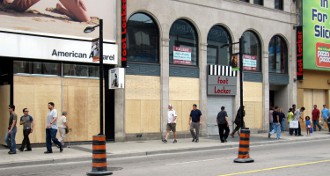 High Street stores are reluctant to stock maternity clothes because they fear there will be too much training involved, a retail analyst has suggested.
High Street stores are reluctant to stock maternity clothes because they fear there will be too much training involved, a retail analyst has suggested.
However a fashion expert, who writes for maternity fashion site Does My Bump Look Good in This?, has disagreed, claiming stores are missing out on a huge demand in the market.
Maternity fashion has become increasingly popular over the past few years, with expectant women, especially those in the business world, relying on this line to keep their style from the first stages of their pregnancy to the very end.
“It’s no longer about tracksuit bottoms and leggings,” a fashion expert pointed out.
“Women want to embrace the latest styles, and stay on-trend through the nine months, and maternity lines are great for doing this,” she added.
However, retailers have been slow to offer this on the shop floor, with small ranges only offered in large flagship stores, which many people are unable to easily get to.
And although there is an abundance of maternity fashion online, it can often be hard for pregnant women to order clothes over the net as a result of their changing figures.
“The high street is missing out on a huge boat,” the fashion expert pointed out.
“Pregnant women want to be able to try before they buy, especially when it comes to jeans and dresses, by not offering these ranges in many stores, retailers are alienating customers wishing to spend, on what is essentially a new wardrobe.”
Clive Longbottom, an analyst at Quocirca, however, had a different view claiming the demand wasn’t there with women only looking to purchase maternity wear later on in their pregnancy.
“[Women who] have gone through pregnancy will use standard clothes for as long as possible, maybe moving from a 12 to a 14 (well, a dress size or two) during the first four or five months and only then look to maternity wear as a move further up would result in badly fitting clothes,” he said.
“I think the majority will then go through a period of still wanting to look good – but towards the end (say, seven months on), comfort becomes the major concern, so elasticated waists and blouses that can billow a little may be OK for many.”
He said this left the main high street shops with a problem as they would then have to come up with a set of designs that fitted in with their standard seasonal offering for a group that was only a small part of a small part of their target audience – those who were more than four or five months pregnant but less than seven months pregnant – in lots of different sizes.
He also pointed out that staff would have to be trained to deal with the needs that a pregnant person has in making sure that things were not too tight.
“Overall, a lot of cost for little return,” he said.
“Leaving it to Mothercare and other specialist stores where women can go, be amongst others in the same position and who will give more balanced judgments than “you still look fat in that”,” would work better he added.
However, the fashion expert disagreed, claiming maternity fashion was no different to other ranges stocked.
“There’s tall, plus size and petite ranges in high street stores, and you don’t see trained staff around for those.
“Maternity is, in my view, just another range. Pregnant women don’t lose their sense of style just because they are having a baby. They don’t need a trained staff member to advise them, they just need a range they can wear, and style themselves.
“The problem is that in so many stores there isn’t this choice, which means women have to try and shop off the rack- this is more likely to warrant trained staff,” she added.
 High street shops are under a lot of pressure from tech savvier e-commerce outfits, but a group of town and city managers believes they can help reverse the trend by enlisting the help of NFC technology.
High street shops are under a lot of pressure from tech savvier e-commerce outfits, but a group of town and city managers believes they can help reverse the trend by enlisting the help of NFC technology.







